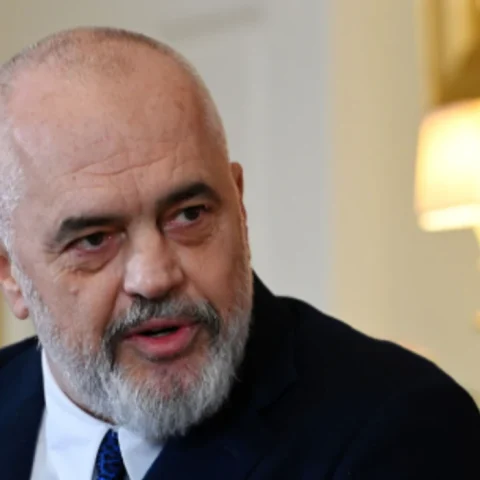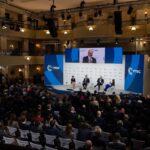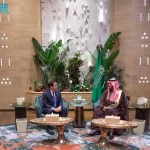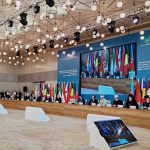By JONATHAN TERRA
Will anything that happened in Vilnius really matter in the foreseeable future? After all, in terms of diplomatic and material support, training, logistics, intel-sharing, and coordinated strategic goals, Ukraine is already a de facto member of the alliance.
The 2023 NATO summit in Vilnius is over. In many ways, it resembled a variety show: there were elements of conflict, excitement, drama, humour, pageantry, irony, sarcasm, resentment, anger, joy, reconciliation and hope.
Dozens of political and military dignitaries gathered for the alliance’s annual meeting only 30 kilometres from the border of Belarus, Russia’s loyal ally in its genocidal war against Ukraine, where the Kremlin claims to have recently transferred tactical nuclear weapons “three times more powerful” than those used in Hiroshima and Nagasaki. Russia added to the densely packed schedule of events with its continued bombardment of civilian targets in at least three Ukrainian cities, including the capital Kyiv, during both days of the summit.
Pump the brakes – you’re not ready
Despite much media reporting to the contrary, the summit ended with few substantive surprises. To a large degree, not only had the agenda been set, but also the outcome.
US President Biden made sure of this. He knows that Washington covers a significant, but seemingly impossible to calculate, share of the alliance’s costs. It also provides indispensable political and diplomatic leadership. Perhaps even more important, it also supplies the ultimate deterrent against Russian aggression aimed at any NATO member state – nuclear weapons – with the independent British and French nuclear forces playing a combined secondary role in strategic deterrence. This gives the US the clout to get what it wants.
Before leaving for his weeklong trip to Europe, with the NATO summit as the centrepiece, President Biden told the world exactly what he wants: to slow down Ukraine’s formal accession to NATO. Biden unmistakably pumped the brakes on Ukrainian membership when he declared: “I don’t think [they’re] ready for membership in NATO.”
Reminding his audience of the mutual defence obligation linked to Article 5 of the NATO charter, he added: “I don’t think there is unanimity in NATO about whether or not to bring Ukraine into the NATO family now, at this moment, in the middle of a war… If the war is going on, then we’re all in war. We’re at war with Russia.”
Biden then pointed out that there are also “other qualifications” before Ukraine can join NATO, “including democratisation”.
The only thing that remained to discover in Vilnius was whether or not the alliance would extend a formal invitation to Ukraine to join at a future date, and what the conditions and timeline for membership would look like. While paragraph 11 of the Vilnius Summit Communiqué declared that “Ukraine’s future is in NATO”, the alliance did not extend an invitation to Ukraine to join with clearly stated timelines and conditions, as President Volodymyr Zelensky had hoped.
On the other hand, the Membership Action Plan (MAP), which the majority of other former candidate states had to follow before accession, was scrapped. Fighting and dying not only to defend their own country from the Russian military, but also the rest of Europe, have effectively been recognized as Ukraine’s “successfully fulfilled criteria” and “feedback mechanism” associated with the MAP.
In addition, the summit launched the NATO-Ukraine Council, a cooperation and consultation mechanism where NATO and Ukraine will meet “to discuss and decide as equals”, according to NATO Secretary General Jens Stoltenberg, whose recent re-election to a one-year extension signalled that the alliance values continuity over change in the middle of Europe’s bloodiest conflict since 1945.
The price of gratitude
Zelensky’s initial reaction after realising that Ukraine would not receive a formal invitation to join NATO meant that Act One of the Vilnius Summit was considerably more dramatic than diplomatic. Before arriving, he tweeted: “It seems there is no readiness neither to invite Ukraine to NATO nor to make it a member of the Alliance”, and that “[i]t’s unprecedented and absurd when [a] time frame is not set” for an invitation and eventual membership. Any delay, in Zelensky’s view, creates the possibility that Ukraine’s membership in NATO will eventually be used as a bargaining chip in any future negotiated settlement to end the Russian war, which would only encourage the Kremlin “to continue its terror”.
Zelensky’s heated tweets prompted a series of unfortunate jabs at him for being insufficiently grateful for the support he’s thus far received from NATO member states. British Defence Minister Ben Wallace replied: “Whether we like it or not, people want to see a bit of gratitude”, and, in reference to an earlier visit to Kyiv during which the Ukrainian president immediately presented him with a weapons wish-list after a long train ride, “You know, we’re not Amazon.”
Feelings simmered down later when Zelensky thanked NATO leaders for their “very practical and unprecedented support”. UK Prime Minister Rishi Sunak distanced himself from his defence minister’s comments by assuring the world that, “President Zelenskiy has expressed his gratitude on a number of occasions not least in his incredibly moving address he made in parliament. I know he and his people are grateful to the UK.”
“Interoperable and politically integrated” – now what?
One critical question remains after the close of the 2023 NATO Summit: will anything that happened in Vilnius really matter in the foreseeable future? After all, in terms of diplomatic, moral and material support, training, supply-chain logistics, intelligence-sharing, coordinated strategic goals, and the long-term commitment to ending the Russian Empire as a destabilising force in European geopolitics once and for all by decisively defeating Vladimir Putin’s genocidal anti-Ukrainian crusade, Ukraine is already a de facto member of the NATO alliance.
As paragraph 11 of the Summit Communiqué clearly and simply conveys: “Ukraine has become increasingly interoperable and politically integrated with the Alliance.” These two factors are the very foundation of “belonging” to NATO, albeit informally in this case, with the obligation to supply one’s own troops for local combat operations.
Furthermore, since February 2022, the Ukrainian military has become the most experienced fighting force in the world. This has allowed NATO tacticians to learn from them as well – for example in the use of drones as a means of acquiring real-time battlefield intelligence, targeting coordinates and dropping small payload bombs on infantry, both in trenches and while troops are moving toward new positions. The Ukrainian military has also been highly innovative in the use of off-the-shelf drones, as well as drones with 3-D printed parts. Customised drones and “quadcopters” have also played an important role in night missions since the beginning of the recent counteroffensive.
A commitment & a conundrum
In the end, despite inevitable criticism and recent uncertainty about the future of the alliance, NATO is working as it should, through deliberation, consultation and committed action to help end the war in Ukraine. The Vilnius Summit shows this to be the case, despite President Zelensky not receiving a formal invitation to join: Ukraine has secured a long-term commitment of military and economic aid from the G7; an agreement to begin F-16 fighter jet training for Ukrainian pilots involving 11 partner countries; 700 million euros in further military aid from Germany, among other new bilateral commitments; and formal assurance that “Ukraine’s future is in NATO”. Unlike the cynical Chinese-Russian authoritarian partnership that helped inaugurate Putin’s bloody war, the alliance between NATO and Ukraine is, in fact, a partnership “without limits.”
History has also laid waste to the obtuse, evidence-dodging argument that “NATO expansion” is the cause of Russian aggression – a claim that even Putin seldom makes these days. On the contrary, voluntary “NATO enlargement” has clearly been the effect of Russian aggression, as the most recent cases of Finland and Sweden (whose formal accession Turkey and Hungary have finally pledged to ratify later this year) conclusively demonstrate.
While the Vilnius Summit was always supposed to be about Ukraine, it was fundamentally about Russia, and how to stop it from remaining a permanent security threat to Europe by making the conditions which allow the maintenance of Empire, and all of the openly fascistic practices necessary for it, too costly to continue.
And herein lies the conundrum: the timetable for Ukraine joining NATO is linked to the end of the current war, an event that is not only impossible to predict, but also difficult to define. How will we know when the Russo-Ukrainian War has ended? Could it ever truly be over when Russia’s rulers have an incentive for a permanent “frozen” conflict with the “fictitious” Ukrainian nation, which Putin has made the basis of his political legitimacy not just as head of state, but as dictator, protector and “redeemer” of the Russian nation in a hostile and rotten world that “encircles” it and prevents it from realising its unique destiny as a “special civilisation”?
Courtesy BIRN, Prague.









